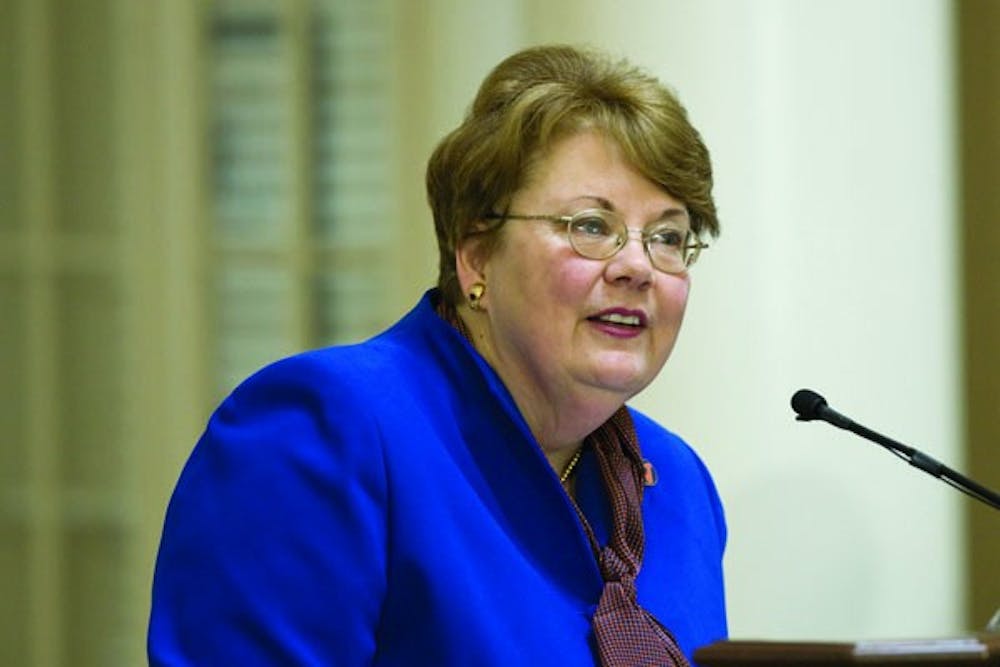University President Teresa Sullivan sat down with The Cavalier Daily Friday morning to discuss the Affordable Excellence initiative that the Board of Visitors approved March 24.
In September 2014, the Commonwealth reported much lower state revenue than had been projected, and as a result cut University funding by $8.2 million — a decrease of 6.6 percent. This cutback, Sullivan said, combined with recent unanticipated costs and the need to hire new faculty and increase research funding to remain competitive, meant the University had to generate additional revenue outside of what the state would provide.
The University found funds by refinancing existing bonds at lower interest rates — allowing the University to spend less on interest — and by increasing endowment payouts in order to reduce the University’s costs, but needed to supplement these sources with a 3.9 percent tuition increase.
President Sullivan called the this change “the lowest increase in ten years at least.” She said it will go toward new resources for libraries, pay raises for faculty and other expenses.
In addition to the 3.9 percent raise, tuition is being raised for incoming students, an added hike which aims to make the University affordable for low- and middle-income families.
“The idea was to keep U.Va. academically excellent, but also to keep it affordable and accessible,” Sullivan said. “That’s a big challenge.”
The program behind the latter tuition is Affordable Excellence, an effort President Sullivan said the Board of Visitors began to seriously discuss in the summer of 2014. She said the plan is designed to reduce the debt of low-income and middle-income Virginians by $10,000 for all four years.
“The University is affordable if people leave with the smallest amount of debt, so they defined affordability in terms of minimizing the amount of debt you have when you leave,” Sullivan said. “Middle income families are typically left out of a lot of the financial aid discussion — we actually have a pretty generous program for middle-income families.”
Sullivan said there are two key aspects to Affordable Excellence — that the University meets one hundred percent of demonstrated need and caps loans for both in- and out-of-state students.
Increased financial aid is aimed specifically at Virginia families, which is why incoming 2015 in-state students will pay a tuition increase of $1,000 and 2016 in-state students will have to pay an additional $1,000 on top of that. Current students will not have to pay these additional costs.
“I want to emphasize that the incoming students who have not yet made their decision about where they’re going to go are subject to this,” Sullivan said. “It was important to the Board to be able to do this while incoming students still had choices to make. The people who have been admitted for next year will now know…what their tuition is and what their financial aid package is, and what their net price will be.”
Because both tuition and financial aid going to Virginia students will increase, revenue for the University will be net neutral. However, this system will minimize debt for lower income families, which Sullivan said broadens career opportunities for graduating students. She said it consequently becomes more realistic for low-income students to attend medical school, law school and graduate business programs.
Virginian students — the population Sullivan said these changes are targeting — comprise 70 percent of the student body. The University estimates that 70 percent of all Virginia students will pay less under Affordable Excellence than they did under AccessUVA.
“An important part of getting a student to consider [U.Va.] is helping them see that they can,” Sullivan said. “I think this will make U.Va. very affordable for a lot of students who previously worried about whether they could afford it. In the long run it’s certainly going to make [U.Va.] more attractive.”
Sullivan said tuition increases going forward should be about one percent plus inflation, barring unforeseen circumstances such as further large budget cuts or other unanticipated costs. She said the University will remain financially attractive to students.
“Even with this increase, U.Va. remains a very good buy, [compared] with almost any comparison you would want to make,” she said.
Although Affordable Excellence was met with much student opposition, Sullivan said she thought it was because the student body did not understand the nuances of the plan.
“I think a lot of people did not understand it,” Sullivan said. “They didn’t know who it applied to… I understand that. Nobody likes seeing their prices rise.”
The speed of the Board’s decision was also met with protest. Sullivan said the Board did not intend to vote on the model the day it was introduced, but reached a consensus so quickly they decided to move forward. She said Affordable Excellence was not as rushed as it appeared.
“There had been several meetings of this subcommittee… looking for what’s affordable, what helps the most families, what’s the minimum amount of tuition you can increase,” Sullivan said. She also said the subcommittee took steps to cut spending before deciding on the tuition increase.
Sullivan said she expects Affordable Excellence will encourage socioeconomic diversity at the University once people understand the model.
“I think we’re trying to give students the best of both: to maintain the excellence of the education, but also keep it affordable,” Sullivan said. “I think that as we get the word out, we’re more likely to diversify. At least we hope so.”







